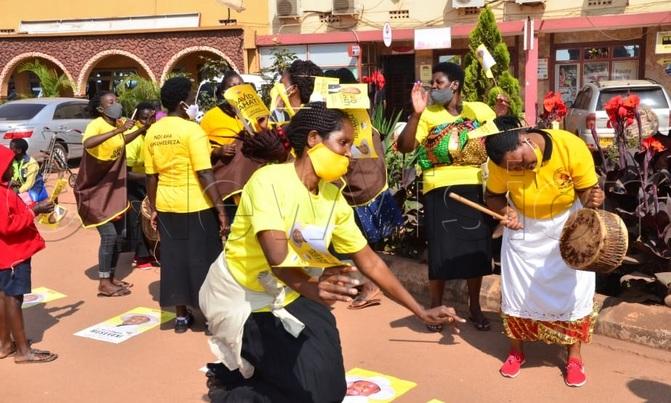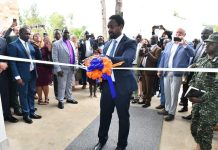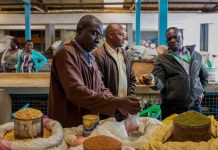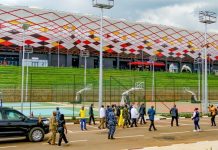Africa-Press – Uganda. The National Resistance Movement (NRM) presidential flag bearer, Yoweri Tibuhaburwa Kaguta Museveni, today starts his campaigns in Kigezi sub-region, sometimes known as ‘The Switzerland of Africa’.
Museveni will address a meeting of NRM leaders from Rukiga, Rubanda and Kabale districts at Kabale municipal stadium at mid-day before addressing the youth later in the evening.
According to David Bahati, the NRM chairperson for Kabale, the party has overwhelming support in the area because of its achievements and plans for the Banyakigezi.
“During the NRM rule, the Kabale-Kisoro road was upgraded, new districts like Rubanda and Rukiga were created and equipped with the necessary requirements. Kabale has been granted a city status effective 2023 among others,” he said.
Bahati said NRM intends to accomplish a number of projects in the next five years, which include the upgrading of various tourism roads in the region and boosting community groups through emyooga initiative.
Nelson Nshangabasheija, the Katuna town council mayor, said a number of residents would like to hear the President’s comment on the Uganda-Rwanda relations that saw Katuna border closed in February last year.
“Most people have had their businesses collapse because they depend much on cross-border trade. Such people wish to hear from the President what their fate is in their nearest future,” he said.
Charlotte Kemigisha, a youth trader from Kabale municipality, said the President needs to empower the youth more since most of them are in the informal sector.
“There is a lot of unemployment in the country and we dearly need a solution from the government as far as empowerment is concerned. The Emyooga initiative is good but it needs to be fast,” said Kemigisha.
About Kabale
Kabale Municipality is one of the old 13 municipalities in Uganda. Kabale Municipality borders with Kitumba sub-county in the south and west, Bubaare in Rubanda district to the north and Kyanamira to the east.
Kabale Municipality is the main centre of activity for Kabale district and entire southwestern Uganda. It is a vibrant town and a regional transport hub because it has the main road links to Kisoro, Kanungu, Kihihi, Ntungamo and Rukungiri districts. It also serves as a transit point to Rwanda through Katuna border situated 22km away from the town and the Democratic Republic of Congo through Kisoro at Bunagana border post. Getting to Kabale from Kampala takes about 6-7 hours on road since it is about 409.1km via Masaka-Mbarara road and Mbarara-Kabale road. Kabale derives its name from a small stone that originated from a piece of iron ore that was so heavy and attracted people from far and wide to appreciate it.
It was first visited by the then colonial district administrator, G.E.E Sullivan. Perhaps due to its picturesque characteristics such as the hills and the cool weather, the colonial government identified the current location of Kabale municipality as the suitable site for the administrative headquarters of Kigezi by 1913.
In 1932, Kabale was recognised as a township authority and was dominated by the Asian traders because of its proximity to the neighbouring countries such as Rwanda, Burundi and the Democratic Republic of Congo.
In 1958, it was declared a town board. It assumed a town council status in 1962 and was declared a municipality in 1984.
In April, it was among the 15 cities that Parliament approved and Kabale will assume a city status in 2023. In terms of area, Kabale municipality is approximately 33 square kilometres. The population living in the municipality is predominantly Bakiga who form the majority, Bafumbira, Banyankole, Banyarwanda, and others include: Baganda, Acholi/Luo, Batoro, and there are no established cultural units.
The municipality occupies part of Makanga hill, Rugarama hill, and Rushoroza hill and extends into the valley between Makanga, Mugabi, Rugarama, Rutooma, Karubanda and Kihumuro hills. The altitude ranges between 1800-2000 metres above sea level.
Kabale exhibits a cool climate with temperatures ranging between 10.9-24.4 degrees with a mean annual rainfall of between 1000-1250mm.
There are two rain seasons with heavier rains occurring between March to May and lesser rains between September and November.
Over the years, there has been tremendous climatic change due to increased human activity in the environment.
Originally, Kabale was associated with very low temperatures, foggy and devoid of malaria, which is common in warmer areas. Today, Kabale is warmer, less foggy and there is an increase in the occurrence of Malaria. Owing to its location in the valley bottom, Kabale faces a serious drainage problem. Large volumes of stormwater descend from the hills on to the town, severely straining the current drainage system.
Kabale’s tourism potential
When you think about visiting Kigezi region, Kabale is undoubtedly the best place to have your most memorable experience of the Switzerland of Africa.
As you head to Kabale municipality, you are assured of stunning scenery characterised by the sprawling hills that would leave any adventurous hiker filled with satisfaction.
The expectation of being hosted at Africa’s second deepest lake, Bunyonyi, makes your trip to Kabale a worthwhile desire.
From Kabale municipality, one can consider a quick visit to Lake Bunyonyi, where a ride around the beautiful lake gives you a perfect description of the wonderful world of God’s creative hands. Endowed with 29 islands, each of these craftily positioned and with unique features from the other.
Kabale is a renowned centre of worship in Uganda with a special touch of exception. For the Anglican faith, the place is popular for the birth of the East African Revival Movement in Uganda. The fruits of this fellowship are still evident up to this day. Energetic songs of praise in the most adorable Kikiga way known as ekiziino will not only wow you but give you a worthy encounter.
After church, most Christians will spend close to an hour interacting with each other and for the Kabale edition heartfelt hugs are a must witness.
Prior to a late evening experience you can opt to visit one of the bushera (a mixture of millet and water) joints and try out a cup or jug of the famous enturire (a mixture of water, sorghum, and honey fermented together) or muramba (a mixture of sorghum and water) drinks. These two special drinks are brewed better from Kabale than any other place in Uganda. If you ever visit Kabale and leave without tasting them, believe me you will have denied yourself a taste of real African perfection.
From there, if you are a pork lover, try out the various joints for this irresistible delicacy which is found on every corner of Kabale town.
Infrastructural development
Kabale’s infrastructure is a moderate one since almost all required infrastructure for an urban setting are available. It is the base for Kigezi’s regional hospital – Kabale Regional Referral Hospital at Makanga hill.
Rugarama Hospital, a missionary private facility, is another option for people who cannot find help at the government referral. More private clinics are available to handle any emergency medical needs.
Education
Under the education sector, Kabale has a public university, Kabale University, which started as a community-university at Kikungiri hill.
The Uganda Christian University constituent college of Bishop Barham University College at Rugarama hill is another option while the Catholic-founded Uganda Martyrs University has a branch in the area as well.
Kabale has several secondary, primary and nursery schools.
For accommodation, Kabale offers both town-based and off-town facilities, especially around Lake Bunyonyi. Prominent accommodation facilities include Cepha’s Inn, White Horse Inn, Capricorn Executive, Bunyonyi Overland Resort and Entusi Resort.
For public transportation around town, travellers have options of either using special hire taxis or bodabodas. Future prospects Apparently, leaders in Kabale Municipality are working hard so that by the time it acquires a city status, the place has a look that it seemingly deserves.
According to the Kabale municipality Mayor, Ssentaro Byamugisha, they are focusing on having a regional city in Kabale since it is the centre of the former Kigezi district.
“We have done most of the street lighting and we are currently focusing on the new central market under construction. Our road network is also being improved in most parts and we hope that by the time we acquire a city status we shall be at a desirable point,” he said.
Byamugisha said with the current degree of decentralisation in the country that is bringing services closer to people and the continued need of people to live in urban areas, city status is the best for Kabale.
Political trends in Kabale
President Museveni has been winning in Kabale district ever since his leadership started. However, in Kabale municipality, the Member of Parliament seat and the mayors have majorly been independents or opposition Forum for Democratic Change.
Currently, NRM appears stronger in the district following its fielding of 100% candidates on each electoral seat in Kabale while other parties still struggle for representation in every position. In the recent youth polls, NRM won all seats in the district.






